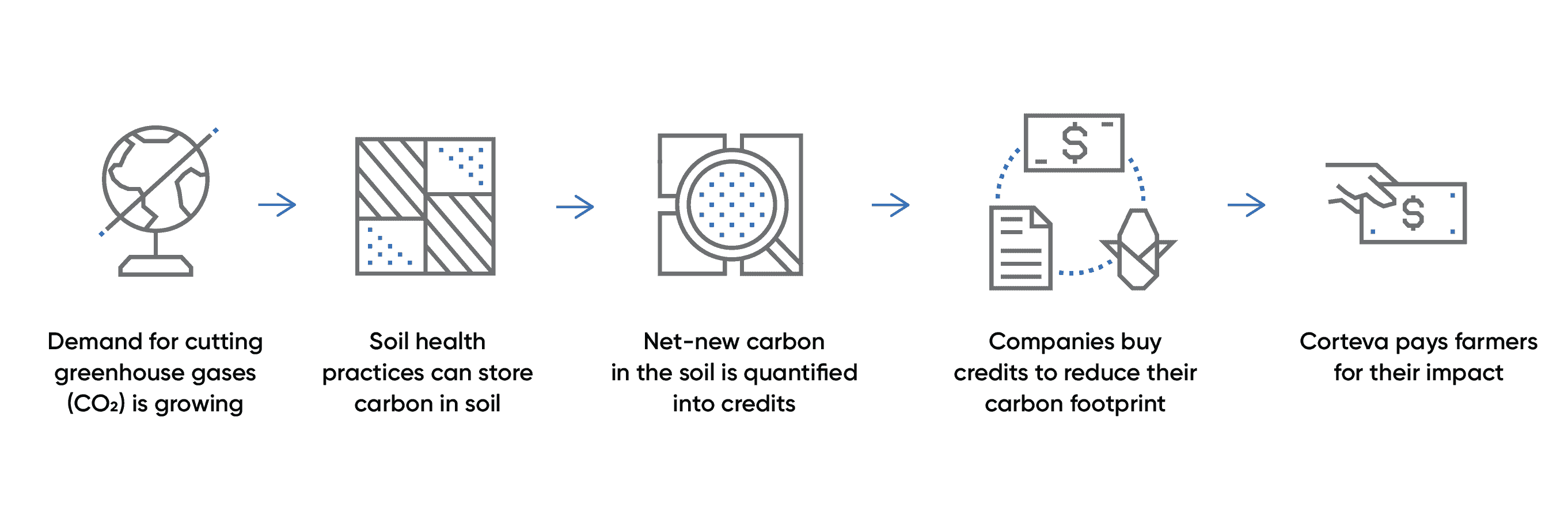Companies are under pressure to reduce their carbon footprint. More than; 80 percent of companies worldwide committed to reducing greenhouse gases through varying practices, including purchasing carbon credits.
Carbon Resource Guide

Carbon may have the spotlight, but many farmers still have questions about this new revenue stream and hwat it means for their farms. This gudie will explore what a carbon program is, how these programs work, and most importantly, the questions to ask as you evaluate a carbon contract.

Why Carbon Markets Exist
To reduce its carbon footprint, a company will cut emissions internally. For example, a corporation like Amazon™ might cut transportation steps in its supply chain or adopt clean energy at a distribution center.
If that’s not enough, the company can “offset” its emissions (i.e., pay for the pollution it can’t reduce). One of the easiest ways to offset emissions is to buy carbon credits through a carbon program or market.

Demand for Carbon Credits Is Growing
The demand for carbon credits is rising, and farmers who enroll in a carbon program will only see the upside in terms of market demand and carbon credit pricing.

Where Ag Comes In
Agricultural carbon programs give farmers the opportunity to make money for the carbon they sequester and/or the emissions they prevent by selling carbon credits to buyers who want to offset their carbon footprint.
Science shows that agriculture can reduce greenhouse gas (CO₂) emissions through soil health practices such as reduced tillage, cover crops or more efficient nitrogen management.
By introducing soil health practices, a farmer can:
- “Sequester” or capture CO₂ from the atmosphere into the soil
- Reduce greenhouse gas emissions
For every 1 metric ton of carbon sequestration or emissions reductions, a farmer earns 1 carbon credit. Your carbon sequestration, or carbon yield, is measured by the practices you choose and data-driven models that predict soil carbon based on soil type and sampling, and weather data.

How Does a Carbon Program Work?


Carbon Program Eligibility
To be eligible for a carbon program, you have to introduce new soil health practices. Before you sign up, ask yourself three important questions:
1. What's my agronomic goal?
Farmers are in the business of growing crops, not carbon. If you’re committed to improving soil health through new practices and reaping the long-term financial and agronomic benefits, then a carbon program will make sense for you. It is important to understand the following considerations before signing up for a carbon program.
- As with any practice change, introducing soil health practices can require trial and error.
- Soil health practices require a longer-term commitment to reap the benefits and have an impact.
- Payments from a carbon program will offset some, not all, of the costs associated with new practice changes.
2. Can I introduce one or more of these eligible practices on my farm?
3. Are these new practices?
Eligible practice(s) must be introduced within the prior crop season to satisfy “additionality” requirements.
- What does additionality mean?
Carbon credits must reflect “net-new” carbon sequestered or emissions prevented through new practice changes — beyond what was happening in that field before the new practice. - Why does additionality matter?
Buyers are under pressure to make a meaningful impact and must ensure their dollars are going towards new or additional carbon sequestered.
What if you introduced these practices years ago?
You still have options.
To be eligible for a carbon program, you can:
- Implement eligible practices on new acres
- Add another practice to existing acres
- Diversify your crop mix

What to Look for in a Carbon Program
Before you sign up for any carbon program, make sure to fully understand three important things.
1. Am I getting top dollar?
- Are my carbon credits independently certified?
Having carbon credits certified by an independent third party confirms that your credits meet the strict standards that buyers want and are willing to pay premium prices for. - Who is buying my credits?
It’s important to ensure that the program has guaranteed buyers lined up. - Am I guaranteed a minimum payment?
Knowing the minimum credit price helps you determine if the program is worth the investment in new practices.
2. What am I committing to?
- Can I make agronomic changes if necessary without penalty?
Farming comes first and you need the flexibility to make agronomic changes based on your cash crop needs. - Can I opt out of the program without penalty?
Stuff happens. If you can no longer resume practices, you will need the option to exit the program without paying money back or a penalty. - Am I locked into a set price for my carbon credits?
Carbon markets are growing and credit prices are rising. You want a program that lets you benefit from market upside.
3. Is it worth my time?
- Will I get agronomic support?
You’ll need advice and agronomic expertise to successfully introduce new practices. - What are the data requirements?
Understand the time and effort that’s required to record your practices plus the cost and ease of use of the software. - Is my data kept private and protected?
Review the program’s commitment to data privacy and protection.
Explore Your Options
All offers updated as of December 2021

What Farmers Want to Know
Farmers aren’t afraid to ask tough questions. We’re here to answer them.
Q&A
Why is an ag company like Corteva offering a carbon program?
A carbon program can help farmers build better soil, reduce greenhouse gases -- and help them make more money along the way. How?
- Building soil carbon leads to more resilient crops and improves soil health
- Agricultural carbon programs are one of the most beneficial and cost-effective ways to reduce greenhouse gas emissions
- Farmers can use income from carbon programs to offset investments in new practice
Why should I join a carbon program now?
Currently, carbon programs only pay for carbon sequestered from new practice changes. That’s what buyers want and are willing to pay premium prices for. Any fields where these practices have already been implemented won’t be eligible.
If you’re considering soil health practices, now is the time to sign up for a carbon program so you don’t risk eligibility later.
What’s stopping a farmer from going direct to a buyer?
Nothing — other than the time, effort, and science needed to generate and sell a carbon credit. To get paid for carbon credits, farmers must measure their carbon sequestration rates field by field, certify their credits with regulatory bodies, and then negotiate credit prices with individual companies.
What happens to carbon programs when the government starts mandating practi
Congress has demonstrated its support of private carbon markets (as shown by the Growing Climate Solutions Act of 2021), and farmer participation in private carbon programs should not affect eligibility for any government program (as is currently the case with government subsidies and cost-sharing programs like EQIP).
How does this work if I’m leasing land? Who gets the payment?
Carbon programs are marketed directly to the individual who is farming the land (i.e., choosing the practice(s)). The farmer — not the landowner — signs the contract and payments go to the contract holder. Depending on the program, you may or may not need signatory permission from the landowner to enroll.
How do carbon programs measure carbon credits?
Carbon programs rely on multiple factors to determine the amount of carbon in soil:
- New and historical management practices
- Soil sampling
- Soil type and weather data
Most carbon programs rely on data-driven models to predict soil carbon outcomes across fields. These models simulate how crops grow — factoring in soil condition and type, plant growth and soil disturbance — to predict soil carbon. There are baseline scenarios for both historical practices and soil health practices. Because it’s not cost effective to sample soils across all enrolled fields, randomized soil samples are often used to validate the models.
Introducing new practices is challenging. How do I know this is the right a
Set a clear objective, start small and tap into your advisors for counsel — it’s the same advice for any new practice you introduce on your farm. For a quick overview of the benefits of these soil health practices beyond just a carbon payment, check out our Soil Health Resource Guide.
What’s it going to cost me?
Any new practice comes with costs. The trick is to see the big picture. For example, costs saved from reducing tillage passes, reduced erosion, and increased organic matter can all help offset investments in new equipment. Likewise, extra revenue from a carbon program can alleviate some of the risks behind new practice changes.


